George B. Berry Chair Professor of Engineering
Professor, Mechanical and Aerospace Engineering
Thermoelectric Ceramics
-
Liang, L., Romo-De-La-Cruz, C.-O., Carvilo, P., Jackson, B., Gemmen, E., Paredes-Navia, S. A., . . . Song, X. (2019). Difference between transition metal cation substitution and Nonstoichiometric addition on nanostructure and thermoelectric performance of complex oxide ceramics. Journal of Solid State Chemistry, 277, 427-433.
 |  |
|---|
This work presents the impact of different methodologies in introducing the transition metal dopants into the thermoelectric Ca3Co4O9 ceramics and their resultant nanostructure and electrical transport properties. The polycrystalline ceramics samples are with designed nominal composition of cation substitution of Ca3Co4-xCuxO9 (x = 0, 0.01, 0.05, 0.1) and cation non-stoichiometric addition of Ca3Co4CuyO9 (y = 0, 0.01, 0.05, 0.1), respectively. At low-temperature regime, the electrical resistivity decreased to the lowest values for each set of samples, upon the minute Cu doping with x = 0.01, and the electrical resistivity increase with Cu doping level. The Seebeck coefficient presents little change among Ca3Co4-xCuxO9 samples. By contrast, the Seebeck coefficient was significantly increased especially in the low-temperature regime in samples of Ca3Co4CuyO9, when the Cu addition level is over y = 0.05. While the grain size and crystal texture status are almost unchanged among Ca3Co4-xCuxO9 samples, non-stoichiometric Cu addition substantially triggered the grain growth, and essentially change the misfit relationship between the Ca2CoO3 and CoO2 layers within the unit cell. The present study demonstrates a novel approach for hierarchically modifying the structure of complex oxide ceramics to tune their thermoelectric properties through cation non-stoichiometric addition.
-
Song, X., Paredes Navia, S. A., Liang, L., Boyle, C., Romo-De-La-Cruz, C.-O., Jackson, B., . . . Chen, Y. (2018). Grain Boundary Phase Segregation for Dramatic Improvement of the Thermoelectric Performance of Oxide Ceramics. Acs Applied Materials & Interfaces, 10 (45), 39018-39024. doi:10.1021/acsami.8b12710
 |  |
|---|---|
 |  |
This work presents a novel approach of dramatically increasing the energy conversion efficiency of thermoelectric CaMnO3−δ ceramics through the combination of lattice dopants substitution and secondary phase segregation at the grain boundaries. The oxide ceramic samples are with the nominal composition of Ca1– xBixMnCuyO3−δ ( x = 0, 0.02, 0.03; y = 0.02, 0.04). When Cu is introduced into the Ca1– xBixMnCuyO3−δ samples, the grain growth from Bi-doped CaMnO3−δ grains is accompanied by the limited solubility of Cu ions in the grain interior, whereas Cu mainly formed a CuO secondary phase at the grain boundaries. Cu nonstoichiometry addition subsequently resulted in the increase of the Seebeck coefficient and decrease of electrical resistivity simultaneously. The sample with designed chemistry of Ca0.97Bi0.03MnCu0.04O3−δ exhibits the power factor of 2.4 mWm–1K–2 at 337 K and figure of merit ZT of 0.67 at 773 K. This ZT of 0.67 is by far the highest ZT reported for various perovskites oxide ceramics. Such enhancements in electrical power factor and the overall ZT are attributed to the synergistic effect of decreasing the carrier concentration to increase the Seebeck coefficient and simultaneously increasing the carrier mobility through the existence of CuO phase at the grain boundaries.
-
Romo-De-La-Cruz, C., Liang, L., Navia, S. A. P., Chen, Y., Prucz, J., & Song, X. (2018). Role of oversized dopant potassium on the nanostructure and thermoelectric performance of calcium cobaltite ceramics. Sustainable Energy & Fuels, 2 , 876-881. doi:10.1039/C7SE00612H
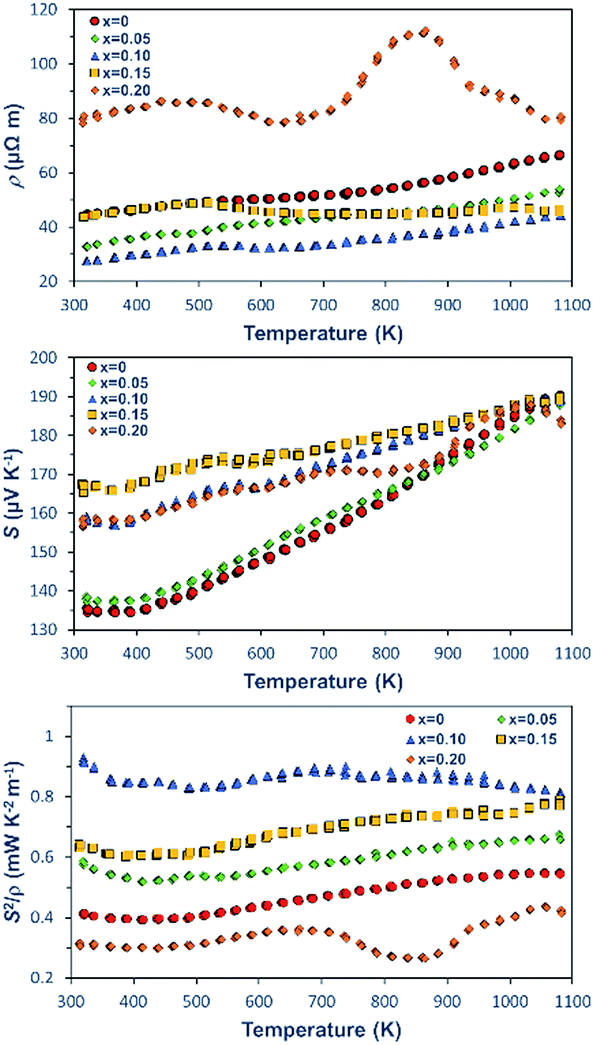 | 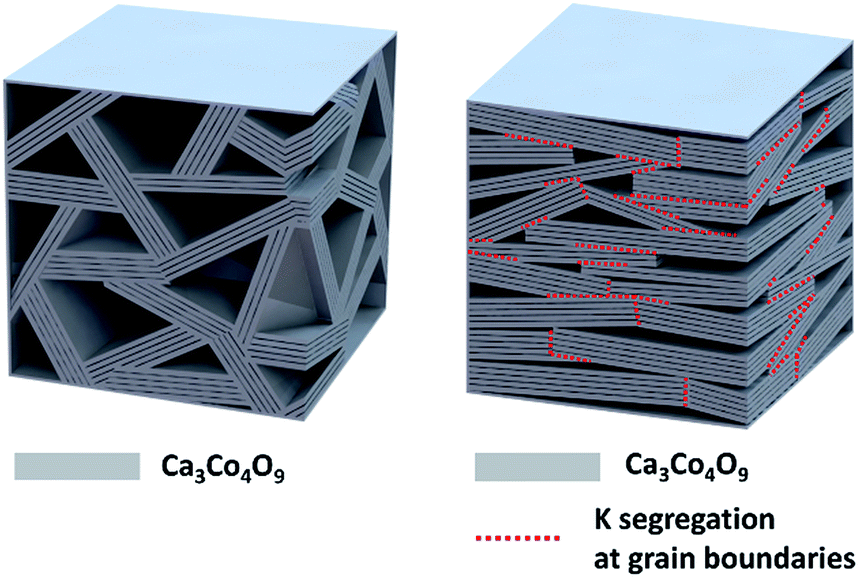 |
|---|
The impact of the non-stoichiometric addition of potassium (K) on the nanostructure and thermoelectric performance of misfit layered calcium cobaltite (Ca3Co4O9) ceramics is reported. The samples were prepared with the designed nominal composition of Ca3Co4O9Kx ( x = 0, 0.05, 0.1, 0.15, and 0.2). The K addition promoted the crystal growth and improved the crystal texture. The nanostructure and chemical analysis revealed the segregation of K at the Ca3Co4O9 grain boundaries, while the Ca3Co4O9 grain interior was free of K. At the optimal doping level, the dopant K grain boundary segregation reduced the electrical resistivity and simultaneously increased the Seebeck coefficient, resulting in a large increase in the power factor. At 320 K, the sample Ca3Co4O9K0.1 achieved the power factor of 930 μW K −2 m −1, which is 2.25 times higher than 412 μW K −2 m −1 from pristine Ca3Co4O9 and by far, the highest power factor at room temperature regime for the Ca3Co4O9 ceramics. The impact of the dopant segregation on the ionic diffusion along the grain boundaries and its resultant thermoelectric performance enhancement of Ca3Co4O9 ceramics are discussed.
-
Boyle, C., Liang, L., Romo-De-La-Cruz, C.-O., Johnson, R., Chen, Y., Prucz, J., . . . Song, X. (2018). Improving the thermoelectric performance and thermal stability of Ca3Co4O9+δ ceramics by sintering in oxygen atmosphere. Journal of Sol-Gel Science and Technology, 85 (3), 712-722.
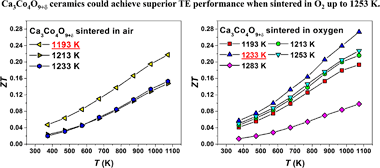 | 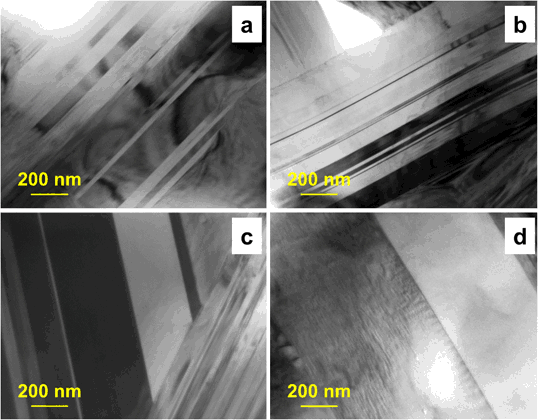 |
|---|
We report on the influence of sintering gas atmosphere on the thermoelectric (TE) performance of Ca3Co4O9+δ ceramics made from precursor powders synthesized using chemical sol–gel route. Two sets of polycrystalline pellets were sintered in air and oxygen atmosphere, respectively. Sintering gas atmosphere and sintering temperature were found to have great influence on the Ca3Co4O9+δ crystal orientation and formation of the Co3O4 secondary phase. All samples, regardless of sintering atmosphere, had similar Seebeck coefficients S that increased with measurement temperature. By contrast, the electrical resistivity ρ changed dramatically as the sintering temperature and atmosphere changed. For samples sintered in air, when the sintering temperature is above 1193 K, ρ increased as the sintering temperature increased. For samples sintering in oxygen, ρ decreased monotonically as the sintering temperature increased up to 1253 K. Benefited from the reduced ρ, the electrical power factor of the sample sintered in the oxygen at 1253 K is 0.539 mW m −1 K −2, and 40% greater than that from the sample sintered at 1193 K in air. Dimensionless figure-of-merit ZT of the sample sintered at 1253 K in oxygen is 0.28 at 1073 K, which is 20% greater than that of samples sintered in air at 1193 K. Overall, the highest TE performance was obtained for Ca3Co4O9+δ ceramics sintered in oxygen at 1253 K, which is significantly higher than the Ca3Co4O9+δ decomposition temperature of 1199 K in air.
-
Talley, K., Barron, S., Nguyen, N., Wong-Ng, W., Martin, J., Zhang, Y., Song, X. (2017). Thermoelectric properties of the LaCoO3-LaCrO3 system using a high-throughput combinatorial approach. Solid State Sciences, 64 , 7-12.
 |
|---|
A combinatorial film of the LaCo1-xCrxO3 system was fabricated using the LaCoO3 and LaCrO3 targets at the NIST Pulsed Laser Deposition (PLD) facility. As the ionic size of Cr 3+ is greater than that of Co 3+, the unit cell volume of the series increases with increasing x. Using a custom screening tool, the Seebeck coefficient of LaCo1-xCrxO3 approaches a measured maximum of 286 μV/K, near to the cobalt-rich end of the film library (with x ≈ 0.49). The resistivity value increases continuously with increasing x. The measured power factor, PF, of this series, which is related to the efficiency of energy conversion, also exhibits a maximum at the composition of x ≈ 0.49, which corresponds to the maximum value of the Seebeck coefficient. Our results illustrate the efficiency of applying the high-throughput combinatorial technique to study thermoelectric materials.
-
Boyle, C., Liang, L., Chen, Y., Prucz, J., Cakmak, E., Watkins, T. R., . . . Song, X. (2017). Competing dopants grain boundary segregation and resultant seebeck coefficient and power factor enhancement of thermoelectric calcium cobaltite ceramics. Ceramics International, 43 (14), 11523-11528.
 |  |
|---|
The present work demonstrates the feasibility of increasing the values of Seebeck coefficient S and power factor of calcium cobaltite Ca3Co4O9 ceramics through competing dopant grain boundary segregation. The nominal chemistry of the polycrystalline material system investigated is Ca3−xBixBayCo4O9 with simultaneous stoichiometric substitution of Bi for Ca and non-stoichiometric addition of minute amounts of Ba. There is continuous increase of S due to Bi substitution and Ba addition. The electrical resistivity also changes upon doping. Overall, the power factor of best performing Bi and Ba co-doped sample is about 0.93 mW m −1 K −2, which is one of the highest power factor values ever reported for Ca3Co4O9, and corresponds to a factor of 3 increase compared to that of the baseline composition Ca3Co4O9. Systematic nanostructure and chemistry characterization was performed on the samples with different nominal compositions. When Bi is the only dopant in Ca3Co4O9, it can be found at both the grain interior and the grain boundaries GBs as a result of segregation. When Bi and Ba are added simultaneously as dopants, competing processes lead to the segregation of Ba and depletion of Bi at the GBs, with Bi present only in the grain interior. Bi substitution in the lattice increases the S at both the low and high temperature regimes, while the segregation of Ba at the GBs dramatically increase the S at low temperature regime.
-
Boyle, C., Carvillo, P., Chen, Y., Barbero, E. J., McIntyre, D., & Song, X. Y. (2016). Grain boundary segregation and thermoelectric performance enhancement of bismuth doped calcium cobaltite. Journal of the European Ceramic Society, 36 (3), 601-607. doi:10.1016/j.jeurceramsoc.2015.10.042
 |  |
|---|
The effect of Bi doping on the nanostructure and thermoelectric performance of the polycrystalline calcium cobaltite Ca3−xBixCo4O9 ( x = 0, 0.1, 0.2, 0.3 and 0.4) is reported. The samples were prepared using a chemical sol-gel route. Increasing Bi concentrations up to x = 0.3 enhance the grain growth and improve the crystal texture. Through nanostructural and chemical analyses, significant Bi segregation at grain boundary was observed for the first time. From 318 K up to 1073 K, the Seebeck coefficient increases and the electrical resistivity decreases as Bi increases to 0.3, resulting in high power factor of 0.95 mW m −1 K −2 at 318 K, which is so far the highest power factor for Calcium Cobaltite ceramics. Combined with low thermal conductivity of 1.9 W m −1 K −1, Ca2.8Bi0.2Co4O9 shows the peak ZT value of 0.43 at 1073 K. The Bi grain boundary segregation improves the texture development and acts as carrier filter in increasing the Seebeck coefficient.
-
Song, X., McIntyre, D., Chen, X., Barbero, E. J., & Chen, Y. (2015). Phase evolution and thermoelectric performance of calcium cobaltite upon high temperature aging. Ceramics International, 41 (9), 11069-11074. doi:10.1016/j.ceramint.2015.05.052
 |  |
|---|---|
 |  |
Crystal phase transformation and their nanostructure evolutions were studied for baseline thermoelectric ceramic Ca3Co4O9, and for a sample aged at 1283 K, which is significantly higher than the Ca3Co4O9 decomposition temperature of 1199 K. X-ray diffraction from both samples only reveals peaks from Ca3Co4O9 phase. TEM examination reveals that in the aged sample, CaO nano-phase exists between neighboring Ca3Co4O9 nano-lamella grains. Moreover, a small amount of Co3O4 and Ca2Co2O5 phase were also observed in the aged sample. The Ca2Co2O5 phase does not exhibit the same lamella nanostructure as Ca3Co4O9 and displayed few crystal defects. Except for Ca3Co4O9, Ca2Co2O5, and Co3O4, no other Ca–Co–O cobaltite phase, such as Ca3Co2O6, was found in the aged sample. Electrical and thermal properties of both baseline and aged sample were measured over the temperature range of 320–1033 K.
-
Carvillo, P., Chen, Y., Boyle, C., Barnes, P. N., & Song, X. (2015). Thermoelectric Performance Enhancement of Calcium Cobaltite through Barium Grain Boundary Segregation. Inorganic Chemistry, 54 (18), 9027-9032. doi:10.1021/acs.inorgchem.5b01296
 |  |
|---|
We report the dramatic increase of the Seebeck coefficient S and thermoelectric performance of calcium cobaltite Ca3Co4O9+δ ceramics through non-stoichiometric addition of minute amount of Ba. The nominal chemistry of polycrystal pellets are Ca3BaxCo4O9+δ ( x = 0, 0.01, 0.05, and 0.1). At 323 K, S of Ca3Co4O9+δ is 135 μV K –1, whereas S of Ba incorporated Ca3Ba0.05Co4O9+δ is 162.5 μV·K –1, which is the highest S value near room temperature regime reported for calcium cobaltite. The increase of S for Ca3Ba0.05Co4O9+δ sample is accompanied by the decrease of the electrical resistivity ρ, resulting in high power factor S 2/ρ of 843 μW·m –1 K –2 at 1007 K. Moreover, the thermal conductivities κ of Ca3BaxCo4O9+δ decrease with the increase of the Ba addition. The figure-of-merit ZT for Ca3Ba0.05Co4O9+δ reaches 0.52 at 1073 K and a factor of 2.5 increment in comparison with undoped Ca3Co4O9+δ. Nanostructure examinations show that the added Ba segregated at the Ca3Co4O9+δ grain boundaries, while the Ca3Co4O9+δ grain interior is free of Ba. Performance enhancement is attributed to the carrier filtering effect caused by the Ba segregation. In addition, Ba segregation promotes the better crystal alignment and the development of crystal texture.
-
Song, X., Chen, Y., Chen, S., Barbero, E., Thomas, E. L., & Barnes, P. (2012). Significant enhancement of electrical transport properties of thermoelectric Ca3Co4O9+δ through Yb doping. Solid State Communications, 152 (16), 1509-1512. doi:http://dx.doi.org/10.1016/j.ssc.2012.06.014
 |  |
|---|---|
 |
We report the significant enhancement of the power factor of Ca3Co4O9+δ through Yb doping. The pellets were prepared by pressing under 0.5 GPa and 2 GPa. The highest power factor of 553 μW m −1 K −2 due to the significant increase of electrical conductivity was obtained for Ca2.9Yb0.1Co4O9+δ pressed at 0.5 GPa. This is 2.3 times higher than that of Ca3Co4O9+δ (246 μW m −1 K −2). Nanostructure examinations show that the pellets pressed at 0.5 and 2 GPa have different nano-lamella structures. This work suggests that Yb is an effective doping element for enhancing the electrical transport properties of Ca3Co4O9+δ, and the optimum doping level is related to the nanostructure of the bulk pellets.
-
Chen, S., Song, X., Chen, X., Chen, Y., Barbero, E. J., Thomas, E. L., & Barnes, P. N. (2012). Effect of precursor calcination temperature on the microstructure and thermoelectric properties of Ca3Co4O9 ceramics. Journal of Sol-Gel Science and Technology, 64 (3), 627-636. doi:10.1007/s10971-012-2894-4
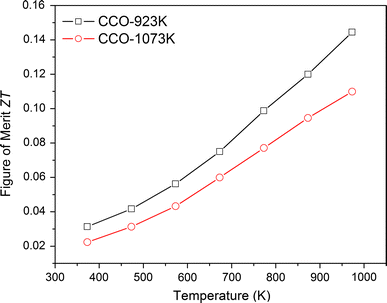 |  |
|---|
Ca3Co4O9 (CCO) powder precursors were prepared by the chemical sol–gel route and calcined at various temperatures between 923 K (CCO-923 K) and 1,073 K (CCO-1,073 K). The calcination temperature was found to be a critical factor affecting the microstructure and thermoelectric properties of CCO ceramic bulk samples. The grain size increases with calcination temperature. The nano-crystals with size about 100 nm in the powders calcined at 923 K promote large crystal growth and texture development during sintering. Bulk pellets made from CCO-923 K powder have large crystal grains, uniform grain size distribution, and a high degree of crystal alignment. By contrast, pellets made from CCO powders at higher calcination temperatures have a bimodal distribution of large and small grains and a large amount of randomly oriented grains. Transmission electron microscopy analysis shows that each crystal grain (identified in SEM images) consists of bundles of CCO nano-lamellas. The nano-lamellas within one bundle share the same c-axis orientation and have fiber texture. The electrical resistivity of CCO-923 K is weakly dependent on operating temperature. Compared to the CCO-1,073 K sample, the CCO-923 K sample has the highest power factor, a lower thermal conductivity, and higher electrical conductivity.